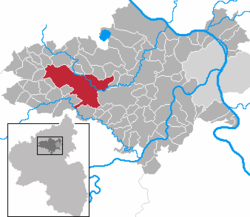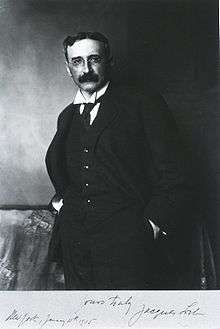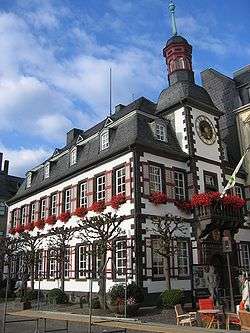Mayen
| Mayen | ||
|---|---|---|
|
Old city hall | ||
| ||
 Mayen | ||
Location of Mayen within Mayen-Koblenz district  | ||
| Coordinates: 50°20′0″N 7°13′0″E / 50.33333°N 7.21667°ECoordinates: 50°20′0″N 7°13′0″E / 50.33333°N 7.21667°E | ||
| Country | Germany | |
| State | Rhineland-Palatinate | |
| District | Mayen-Koblenz | |
| Government | ||
| • Lord Mayor | Wolfgang Treis (Greens) | |
| Area | ||
| • Total | 58.04 km2 (22.41 sq mi) | |
| Population (2015-12-31)[1] | ||
| • Total | 18,818 | |
| • Density | 320/km2 (840/sq mi) | |
| Time zone | CET/CEST (UTC+1/+2) | |
| Postal codes | 56727 | |
| Dialling codes | 02651 | |
| Vehicle registration | MYK, MY | |
| Website | www.mayen.de | |
Mayen is a town in the Mayen-Koblenz District of the Rhineland-Palatinate Federal State of Germany, in the eastern part of the Volcanic Eifel Region. As well as the main town, additional settlements include Alzheim, Kürrenberg, Hausen-Betzing, Hausen and Nitztal. Mayen is the administrative centre of the Vordereifel ‘Collective Municipality’, although it is not part of the municipality.
Geography
To the west, as well as to the north and south-west of Mayen, is the country landscape of the Eifel. To the east, the landscape flattens out, running towards the Koblenz-Neuwied Basin, which is divided into the northern section of Pellenz and the southern section of Maifeld. This area is geographically considered to be part of the Eifel. Mayen is often called ‘The Gateway to the Eifel’.
The small river Nette runs through the town, flowing from the Eifel towards Weißenthurm on the Rhine.
History
Even in Roman times, Mayen (Lat. Megina) was an important economic centre. From the end of the 3rd century up until the Middle Ages, potteries operated here, and their products were traded and sold across Central Europe. During prehistoric times, nearby quarries were the sources of basalt to make millstones and tuff used to make sarcophagi. These sarcophagi were found buried with significant glass artifacts as grave goods. (Both classes of items are displayed in the Genovevaburg Museum in Mayen).
The name Mayen probably comes from the name Megina. Records from as far back as 847 show this as a designation of the town; it was adapted by the Romans from the Celtic word magos, meaning field. In the 8th century the legend of Genoveva of Brabant, names Mayen as the seat of government of Duke Siegfried of the Pfalz.
Mayen received its first official recognition in 1041, and was granted Town Status in 1291 from Rudolf I von Habsburg, at the same time as Bernkastel, Welschbillig, Montabaur and Saarburg. Mayen is possibly linked to the town of Maifeld, which lies a short distant to the south-east, since Mayen was called the capital of the Meiengau in the Middle Ages.
During the Second World War, in particular during the allied forces air attacks of 12 December 1944 and 2 January 1945, approximately 90% of the town was destroyed. After the war and following a special referendum which addressed costs of rebuilding, the people voted to rebuild the town.
Up until 1973, Mayen was the District Centre of the Mayen District (with number-plate code MY). After 1973, the district administration was moved to Koblenz and the District was renamed Mayen-Koblenz District with the new number-plate code of MYK; Koblenz kept its own code of KO.
Boroughs
Because of the Kommunalreform in 1970, four villages next to Mayen were incorporated. The four villages now belong officially to the town and became Boroughs of Mayen. The Boroughs are still village-like and hold most of the Agriculture of Mayen. The Boroughs are
- Alzheim (Population approx. 1300), to the south
- Hausen (Population approx. 1500), to the east, towards Koblenz
- Kürrenberg (Population approx. 1200), to the west, towards Nürburgring
- Nitztal (Population approx. 180), to the north, towards Schloss Bürresheim
The population of Alzheim and Hausen is increasing in the last years, due to the development of new residential areas.
Infrastructure
- Favourable location between A 61 (Cologne, Ludwigshafen) and A 48 (Trier, Koblenz).
- Train connection: the Trans Regio branch line goes from Andernach, which is on the Koblenz to Cologne route, to Kaisersesch in the Eifel, through Mayen Ost and, less frequently, through Mayen West.
- Regular (hourly) bus routes to/from Andernach, Neuwied and Koblenz, as well as westwards into the Eifel. The town is part of the Verkehrsverbund Rhein-Mosel (Rhine-Mosel Transport Network).
- Various shopping and business areas; several supermarkets from national chains; many clothes, sports, stationary and other shops; a cinema; various petrol stations; a large furniture store; a DIY store as well as building-supply stores. Most of these are located in a shopping area on the outskirts of the town, towards Koblenz.
- The town centre is very attractive and has a large pedestrian precinct.
- The town has its own hospital, the St Elisabeth Krankenhaus, and emergency services.
Industry
Basalt mining, slate mining, cardboard industry, machine-production, aluminium- and artificial material processing.
Sights

- Genovevaburg from the 13th century, with the Eifel Museum and the Slate Mining Museum housed inside.
- St Clemens Parish Church with its twisted spire (symbol of the town, rebuilt in 1945)
- Herz-Jesu Church (built in 1911/12)
- Volcanic Information Station in the Vulkanpark (Volcanic Park).
- Nearby in the Nette Valley: Schloss Bürresheim, which was filmed as Castle Grunewald in the United States adventure film, Indiana Jones and the Last Crusade.
- Swimming and leisure pool, with one of the longest hanging water slides in the world.
Events
- Lukasmarkt: yearly fair in October with rides and amusements for a week, as well as a two-day livestock market (the founding event of the fair).
- Burgfestspiele (Castle Festival Show): for several weeks in late spring, the courtyard of the castle is transformed into an open-air theatre and used for various productions.
- Stein- und Burgfest (Stone and Castle Festival); local craftsmen and guilds showcase their trade. Usually for two days towards in September.
Education
Mayen is the location of
- Fachhochschule für öffentliche Verwaltung (Training College for Public Administration),
- two Gymnasien (top-level secondary schools): the Megina Gymnasium and the Wirtschaftsgymnasium (Economics Grammar School);
- a Realschule (middle-level secondary school): the Albert-Schweizer-Realschule;
- two Hauptschulen (lower-level secondary school): Hinter Burg, St Veit; a Berufschule (vocational school);
- various Grundschulen (primary schools);
- two Förderschulen (schools for children with disabilities); and
- vocational schools: ine for beekeeping school, and one for stonemasonry.
The Bundeswehr (German Armed Forces) has a forces school at the Mayen Barracks, where troops are trained for psychological aspects of leadership of operations, as well as dealing with the media. This school is unique in Germany. Michigan State University, based in Michigan, the United States, has a summer program in Mayen.
Notable residents and natives
- Emmy Kreiten-Barido (1894–1985), singer and mother of the martyred Karlrobert Kreiten
- Reinhard Saftig (born 1952), football player and trainer
- Mario Adorf (film and stage actor, author)
- Balthasar Krems (inventor of the sewing machine)
- Jacques Loeb 1859–1924, physiologist and biologist

- Stephan Ackermann (born 1963), bishop
- Henry Alken (1753-1827), sculptor and painter
- Carl Burger (1875-1950), sculptor
- Marc Hennerici (born 1982), racing driver
- Tim Kruse (born 1983), football player
- Werner Lamberz (1929-1978), member of the Politburo of the Central Committee of the SED in GDR.
- Dominik Meffert, (born 1981), tennis player
- Friedrich Wilhelm Raiffeisen (1818-1888), social reformer and founder of the cooperative movement, was District Secretary in Mayen and church hosts the Evangelical Church of Mayen

- Winfried Schäfer (born 1950), football player and coach
- Fritz Seitz (1905-1949); Catholic Priest in Diocese of Speyer, longtime prisoner in Dachau concentration camp
Mayen
Twin towns
Mayen’s twin towns are: Joigny in France, Godalming in England, Uherské Hradiště in the Czech Republic and Cyabingo in Rwanda.
References
- ↑ "Gemeinden in Deutschland mit Bevölkerung am 31. Dezember 2015" (PDF). Statistisches Bundesamt (in German). 2016.
External links
| Wikimedia Commons has media related to Mayen. |

